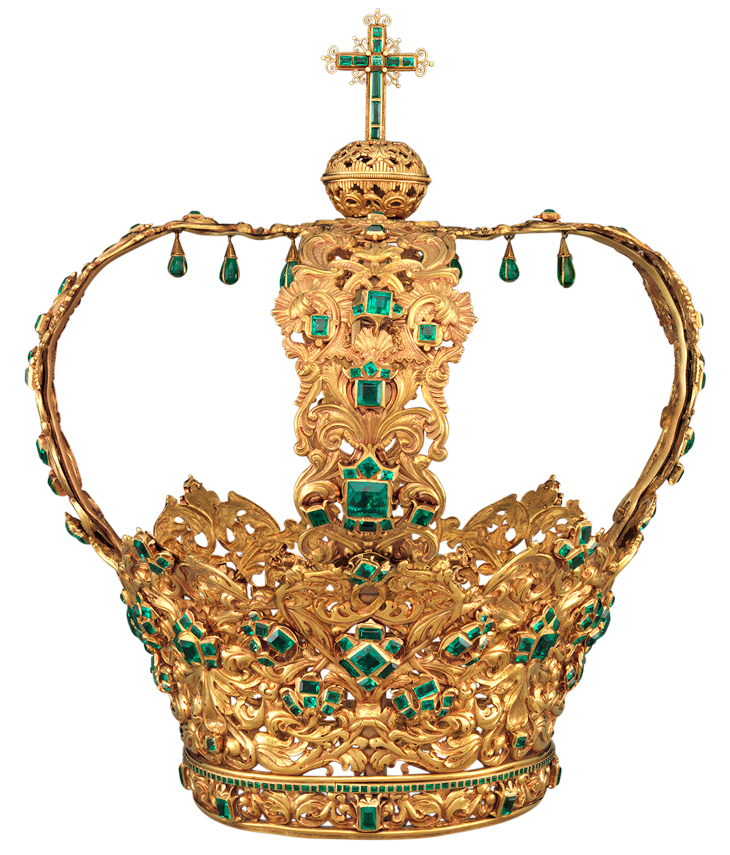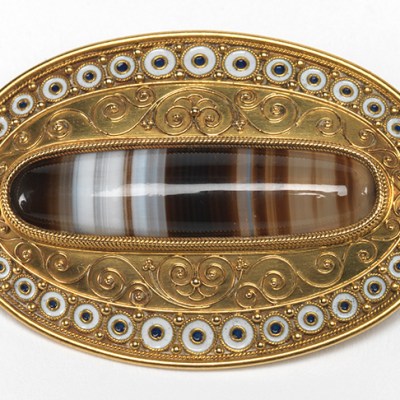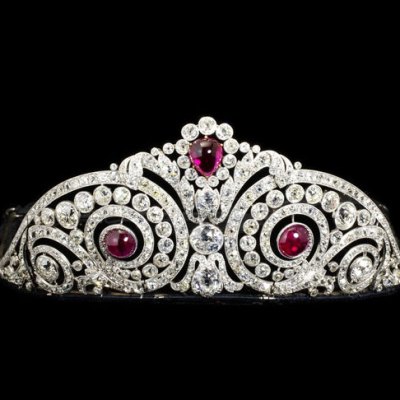Spotlit in the otherwise dark opening room of ‘Jewelry: The Body Transformed’ at the Metropolitan Museum of Art, dozens of pieces of jewellery gleam under tall glass columns. Here, visitors encounter a breadth of objects from different cultures: simple wig rings from ancient Egypt are displayed as prominently as an ostentatious gold-and-emerald crown from the 18th-century Colombian church; nose and lip ornaments from South America and Polynesia stand side by side with Art Nouveau necklaces and Tiffany brooches. The juxtaposition of objects with similar functions but different origins, even within the same display case, may upend the visitor’s expectations about temporal or geographical provenance: an Elsa Schiaparelli black silk belt, embellished with a pair of pearly, clasped hands, could easily pass as a medieval relic. Clearly, good design and fine craftsmanship have long been guiding principles for jewellery-makers across the globe.
Orchid brooch (1889–96), designed by Paulding Farnman for Tiffany & Co. Metropolitan Museum of Art, New York

There is minimal interpretive material elucidating or connecting the objects: the aim, it seems, is to submerge visitors in a sense of awe, to facilitate a sort of parallel experience with the wonder others in history may have felt when first confronted with such a wealth of light and beauty. Yet the diversity on display makes the experience at once overstimulating and insubstantial.
Contextualisation comes in subsequent thematically arranged rooms that explore interactions between jewellery and the body across time and space. A gallery devoted to ‘The Divine Body’ explores jewellery’s first great purpose: to ensure human entry into the heavenly realms. We find gold – prized by many cultures as a divine substance for its resemblance to the sun – in almost every artefact, from toe-protecting ancient Egyptian sandals (constructed to guard the integrity of the human body on its journey into the afterlife) to small bells, whose sonic and reflective qualities ‘called’ the gods as the wearer moved. ‘The Regal Body’ develops the link between jewellery and social hierarchies to show how political rulers used gems to assert themselves as the human embodiments of divine spirits – best expressed perhaps in the case of the Mayan rulers, who wore jade ear flares representing the Maize Gods, which were thought to whisper sage advice into their ears.
Crown of the Virgin of the Immaculate Conception, known as the Crown of the Andes (diadem: c. 1660; arches: c. 1770), Colombian. Metropolitan Museum of Art, New York

The exhibition also explores the nuanced relationship between gender and jewellery, particularly in its sections on the ‘Transcendent’ and ‘Alluring Body’. Whereas men have adorned themselves to demonstrate their power and virility – think a feathered war charm from Papua New Guinea or a bejewelled smallsword hilt from 18th-century Europe – women have often been draped in gems that broadcast their economic worth and fertility. One particularly striking example of the latter is a silver crown, bracelet, and plaiting set from the Turkmen tribes of Central Asia. This bridal collection was supplemented with gems as the girl approached marital age, culminating in a heavy ensemble that looks stunning but painful to wear. The link between pain, gender, and jewellery becomes more explicit with modern pieces like Shaun Leane’s silver ‘Crown of Thorns’ and ‘Yashmak’ aluminium-and-crystal plate bodysuit, which play with two well-worn adages: that beauty is pain, and that femininity, with all its thorny expectations, can be a cage.
Yashmak (2000; edition from 2017), designed by Shaun Leane for Alexander McQueen. Metropolitan Museum of Art, New York

The final section, ‘The Resplendent Body’, presents the exhibition’s best, brightest and sometimes strangest creations. In their time, many of the objects on display here were considered inventive or shocking, such as the ‘Incubus’ necklace by Simon Costin from 1987, a lacy gothic confection of baroque pearls and vials of semen. Now, this work is seen as a clear example of the cyclical nature of much art and design – using new materials and methods, while drawing inspiration from past eras. Appropriately, visitors must exit the exhibition through the opening room, where newfound knowledge can now furnish a deeper appreciation of the jewels on display. Some may even feel a heightened sense of wonder at the sight of their reflections in the glass, from some angles appearing to wear the jewellery behind it.
‘Jewelry: The Body Transformed’ is at the Metropolitan Museum of Art, New York, until 24 February.



